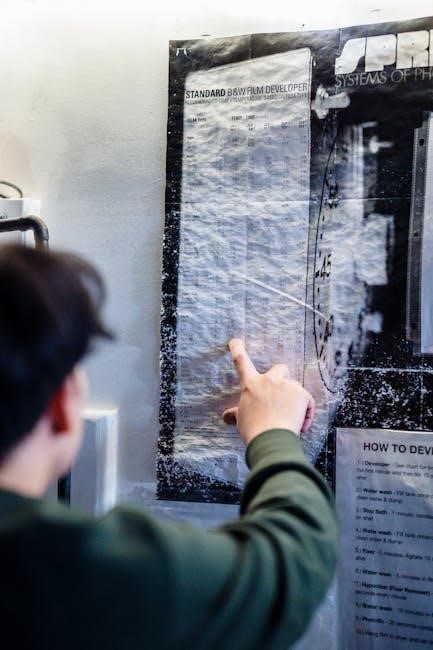The NJ K-1 form provides essential guidance for partnerships filing in New Jersey, detailing income reporting, deductions, and partner allocations. It ensures compliance with state tax requirements accurately.
1.1 Purpose and Scope of the NJ K-1 Form
The NJ K-1 form is designed to provide detailed information to partners regarding their share of income, deductions, and credits from a New Jersey partnership. Its primary purpose is to ensure accurate reporting of each partner’s distributive share, which is essential for filing individual tax returns. The form covers various components such as ordinary income, guaranteed payments, interest, dividends, royalties, capital gains, and specific deductions. It also addresses special adjustments, including Koch type adjustments, which are critical for compliance with New Jersey tax laws. The scope of the NJ K-1 extends to guiding partnerships through state-specific tax requirements, ensuring that all income and deductions are properly allocated and reported. This form is a vital tool for maintaining tax compliance and transparency among partners.
1.2 Structure of the NJ K-1 Instructions
The NJ K-1 instructions are organized to guide partnerships through accurate reporting of income, deductions, and credits. The document begins with an overview of the form’s purpose and scope, followed by detailed explanations for each line item. Key sections include instructions for reporting ordinary income, guaranteed payments, interest, dividends, royalties, and capital gains. Special adjustments, such as Koch type adjustments, are also addressed, with step-by-step guidance on how to calculate and report these items. The instructions emphasize proper allocation of income and deductions to ensure compliance with New Jersey tax laws. Additional sections cover electronic filing options, paper filing procedures, and resources for assistance, making the instructions a comprehensive guide for partnerships filing in New Jersey.
1.3 Important Notes for Filers
Filers must ensure accuracy when completing the NJ K-1 form, as errors may lead to delays or penalties. Partnerships are required to report all income and deductions allocated to each partner. The instructions highlight the importance of maintaining detailed records to support all entries. Additionally, filers should be aware of specific deadlines and extensions, as failure to meet these may result in late filing penalties. Electronic filing is encouraged for faster processing, but paper filers must follow mailing instructions carefully. Filers are also reminded to review special adjustments, such as Koch type adjustments, and ensure all calculations are correctly reported. Proper signature and documentation are essential for compliance with New Jersey tax regulations.

Eligibility and Requirements
The NJ K-1 is required for partnerships with income sourced in New Jersey. Filers must meet specific partnership criteria outlined in the instructions to ensure compliance and avoid penalties.
2.1 Who Needs to File the NJ K-1?
The NJ K-1 form is required for partnerships and other pass-through entities conducting business in New Jersey. Filers include general and limited partnerships, limited liability companies (LLCs) taxed as partnerships, and other entities that allocate income to partners or members. The form is necessary for reporting each partner’s share of income, deductions, and credits, ensuring compliance with New Jersey state tax laws. It applies to entities with income sourced within the state, regardless of the partners’ residency. Accurate completion of the NJ K-1 is essential for both the entity and its partners to meet tax obligations and avoid penalties.
2.2 Partnership Requirements for Filing

Partnerships must file the NJ K-1 form if they have income sourced in New Jersey or are required to file a New Jersey partnership return. The form requires accurate documentation of each partner’s share of income, deductions, and credits. Partnerships must allocate income based on the partnership agreement or state law. Additional requirements include reporting taxes based on income that were deducted to determine ordinary income (loss) on Line 1, Schedule K. The form must also account for Koch type adjustments and include the NJ-NR-A form if applicable. Partnerships are responsible for ensuring all data is correct and complete before submission to avoid penalties.
2.3 Deadlines and Extensions
The NJ K-1 form must be filed by the same deadline as the partnership’s federal tax return, typically April 15th for calendar-year partnerships. Extensions may be requested, granting an additional six months to file. However, any tax owed must be paid by the original deadline to avoid penalties and interest. Partnerships can request an extension via electronic filing or by mail, using Form NJ-1065-V. Late filing or payment may result in penalties and accrued interest. It is crucial to adhere to these deadlines to maintain compliance with New Jersey state tax requirements. Ensure all necessary documentation and payments are submitted timely to avoid additional charges.

Key Components of the NJ K-1 Form
The NJ K-1 form includes ordinary income, guaranteed payments, interest, dividends, royalties, capital gains, Section 179 deductions, and other deductions, ensuring accurate reporting of partnership income and expenses.
3.1 Line 1: Ordinary Income (Loss) from Trade or Business Activities
Line 1 of the NJ K-1 form captures the ordinary income or loss derived from the partnership’s trade or business activities. This includes revenue from operations, sales, and services. Filers must report both positive income and losses, ensuring accurate representation of business performance; The amount should align with the partnership’s federal tax return, excluding any non-business income. Special rules may apply for passive activities or investments. Proper documentation and adherence to IRS guidelines are essential for accurate reporting. This section is critical for reflecting the partnership’s operational profitability or loss, directly impacting each partner’s taxable income. Always consult official state guidelines for specific instructions and updates.
3.2 Line 2: Guaranteed Payments to Partners
Line 2 of the NJ K-1 form is designated for reporting guaranteed payments to partners. These payments are made to partners for services rendered or capital contributions, regardless of the partnership’s profit. They are taxable to the partner as ordinary income. The amount reported here should reflect the total guaranteed payments made to all partners during the tax year. This section does not include distributions of profit or loss. Filers must ensure the amounts are consistent with the partnership’s federal tax return. Each partner’s share of guaranteed payments must be detailed accurately. This line is essential for ensuring proper tax reporting for both the partnership and its partners. Always refer to official state guidelines for specific reporting requirements.
3.3 Line 3: Interest Income
Line 3 of the NJ K-1 form is used to report interest income earned by the partnership. This includes interest from bank accounts, bonds, and other investment activities. The amount shown here represents the total interest income allocated to the partnership during the tax year. It does not include interest from exempt obligations, such as certain government bonds, which are excluded from taxable income. The partnership must ensure the interest income reported aligns with federal tax reporting standards. Partners should review this line to understand their share of the partnership’s interest income. Detailed breakdowns may be provided in additional schedules or statements. Always verify the accuracy of the amounts reported to ensure compliance with state and federal tax regulations.
3.4 Line 4: Dividend Income
Line 4 of the NJ K-1 form is designated for reporting dividend income earned by the partnership. This includes dividends received from domestic and foreign corporations. Dividend income is generally reported as passive income and is subject to state taxation. However, dividends from certain tax-exempt entities, such as governmental bodies, may not be included here. The amount reported on this line should align with federal tax reporting standards. Partners should review this line to determine their share of dividend income, which may impact their individual tax obligations. Additional details or breakdowns of dividend income may be provided in supplementary schedules or statements. Ensure accuracy when reporting this income to comply with state tax requirements.
3.5 Line 5: Royalty Income
Line 5 of the NJ K-1 form is reserved for reporting royalty income earned by the partnership. Royalties are payments received for the use of property, such as patents, copyrights, trademarks, or natural resources. This income is typically considered passive and is subject to state taxation. Filers must ensure that all royalty payments are accurately reported here, excluding any royalties exempt under specific tax laws. Partners should review this line to determine their share of royalty income, which may affect their individual tax returns. Proper documentation, such as licensing agreements, should support the amounts reported. Ensure compliance with New Jersey tax regulations when disclosing royalty income on this line.

3.6 Line 6: Capital Gain/Loss

Line 6 of the NJ K-1 form is used to report the capital gain or loss from the sale or exchange of partnership assets. This includes gains from the sale of property, such as real estate, equipment, or investments, as well as losses incurred from such transactions. The gain or loss is calculated based on the difference between the sale price and the adjusted tax basis of the asset. Partnerships must report both short-term and long-term gains/losses, with the net gain or loss reported on this line. Filers should ensure accurate reporting, as this directly impacts each partner’s tax liability. Proper documentation, such as sale agreements and asset basis calculations, should be maintained to support the amounts reported. Compliance with New Jersey tax regulations is essential when completing this section.
3.7 Line 7: Section 179 Deduction
Line 7 of the NJ K-1 form is designated for reporting the Section 179 Deduction, which allows businesses to deduct the full cost of eligible property in the year it is purchased. This deduction applies to certain business assets, such as machinery, equipment, and software. The partnership must calculate the total Section 179 deduction for the tax year and report it here. Filers should ensure compliance with both federal and New Jersey-specific limits on the deduction. The amount reported on Line 7 is allocated to each partner based on their share of partnership income. Proper documentation, such as records of qualifying assets and their costs, is essential for accurate reporting. This deduction can significantly impact a partner’s taxable income, so precision is critical.
3.8 Line 8: Other Deductions
Line 8 of the NJ K-1 form is reserved for reporting Other Deductions that are not specifically addressed in the preceding lines. These deductions may include expenses such as rent, utilities, insurance, and professional fees. Filers must ensure that all deductions reported here are properly itemized and supported by documentation. The partnership should allocate these deductions proportionally to each partner’s share of income. It is essential to review New Jersey-specific guidelines to ensure compliance with state regulations. Accurate reporting of these deductions is crucial, as they directly impact the taxable income distributed to partners. Filers should consult the instructions or seek professional advice if unsure about eligible deductions. Proper documentation is key to avoiding discrepancies or audits.

Filing and Submission Process
The NJ K-1 filing process involves preparing the form, utilizing electronic filing options, and following specific mailing instructions for paper submissions, ensuring timely and accurate compliance.
4.1 Preparing the NJ K-1 Form
Preparing the NJ K-1 form requires careful attention to detail and accurate reporting of partnership income, deductions, and credits. Begin by gathering all necessary documents, including Schedule K-1 (Form 1065) and supporting financial statements. Ensure all partner information, such as names, addresses, and ownership percentages, is up-to-date. Review each line of the form to verify accuracy, paying special attention to items like ordinary income, guaranteed payments, and capital gains. Allocate income and deductions proportionally based on partnership agreements. Double-check calculations to avoid errors. If the partnership has complex transactions, consult a tax professional to ensure compliance with state regulations. Accurate preparation is essential to avoid delays or penalties during filing.
4.2 Electronic Filing Options
The New Jersey Division of Taxation offers electronic filing options for the NJ K-1 form, making the process faster and more efficient. Partnerships and LLCs can use the NJ Taxation Portal or approved tax software to submit their returns. Electronic filing reduces errors and ensures compliance with state requirements. Filers can upload required documents and verify data in real-time. Once submitted, the system provides confirmation, and processing times are typically shorter compared to paper filing. Taxpayers can also check the status of their submission online. To use this option, filers must register for an account or use compatible software. Electronic filing is secure and recommended for accuracy and convenience.
4.3 Mailing Instructions for Paper Filers
For partnerships filing the NJ K-1 form by mail, ensure the form is properly completed and signed. Include all required schedules and attachments. Mail the form to the address listed in the instructions, which varies based on the partnership’s income type. Use a sturdy envelope and affix the correct postage. Do not fold or staple the form to prevent processing delays. Consider using a trackable shipping method for confirmation. The postmark date determines timeliness, so mail early to meet deadlines. Avoid sending via certified mail, as this can delay processing. Ensure the return address is clearly printed to receive any correspondence. Mailing instructions are detailed in the NJ K-1 booklet to ensure compliance and avoid penalties.

Special Instructions and Adjustments
This section provides guidance for unique filing situations, including adjustments to income, deductions, and credits. It also covers special rules for specific types of partnerships and income.
5.1 Koch Type Adjustments
Koch Type Adjustments are specific modifications to a partner’s distributive share, typically related to the treatment of certain income or deductions. These adjustments ensure that items like guaranteed payments, depreciation, or depletion are correctly allocated. Filers must carefully review the partnership agreement and federal Schedule K-1 to determine if any Koch adjustments apply. The adjustments are calculated by comparing the partner’s federal and state shares, ensuring compliance with New Jersey tax laws. Proper documentation is essential to avoid discrepancies. If unsure, filers should consult the NJ K-1 instructions or seek professional advice to ensure accurate reporting. These adjustments are crucial for maintaining compliance and preventing potential audit issues.
5.2 Totaling Lines 15a through 15g
Lines 15a through 15g of the NJ K-1 form represent specific adjustments or credits that may apply to a partner’s distributive share. Filers must carefully total these amounts to ensure accuracy. Each line corresponds to a unique adjustment, such as net operating losses or special deductions. Add the values from these lines and enter the total on Line 15h. It’s important to verify that no single line exceeds the allowable limit, as this may require additional forms or explanations. If unsure about the calculations, filers should consult the instructions or seek professional assistance. Accurate totaling is crucial to avoid errors or delays in processing the return. Always double-check the math to ensure compliance with New Jersey tax requirements.
5.3 Entering the Result on Line 15h

After totaling Lines 15a through 15g, the result must be entered on Line 15h of the NJ K-1 form. Ensure the amount is accurately transcribed, as this figure represents the cumulative adjustments applicable to the partner’s share. If the total exceeds the allowable limit for a single line, additional forms or schedules may be required. Filers must also consider any carry-over amounts from previous years. For negative results, ensure the value is properly indicated. This step is critical for accurate tax reporting. Always double-check the calculation before finalizing the form. If unsure, consult the instructions or seek professional guidance to ensure compliance with New Jersey tax regulations. Precision in this step is essential for avoiding errors or delays in processing.

Additional Resources and Support
The NJ K-1 instructions provide additional resources such as contact information, online tools, and printable forms to help filers complete their returns accurately and efficiently.
- Contact the New Jersey Division of Taxation for assistance.
- Access online tutorials and downloadable templates.
- Refer to printable forms for manual filing.
6.1 Contact Information for Assistance
For questions or help with the NJ K-1 form, contact the New Jersey Division of Taxation. Call the Business Tax Services hotline at (609) 292-6400 or the General Tax Assistance hotline at (609) 292-6400. You can also email questions to taxation@nj.gov. Visit the official website at https://www.state.nj.us/treasury/taxation/ for forms, instructions, and additional resources. The NJ Division of Taxation is located at 50 Barrack Street, Trenton, NJ 08695. Office hours are Monday through Friday, 8:30 AM to 4:30 PM, excluding state holidays. Representatives are available to assist with filing requirements and address specific concerns.
6.2 Online Tools and Tutorials
The New Jersey Division of Taxation provides online tools and tutorials to help filers complete the NJ K-1 form accurately. Visit their official website at https://www.state.nj.us/treasury/taxation/ for access to resources. The site offers video tutorials, step-by-step guides, and interactive tools to assist with understanding the form. Additionally, webinars are periodically available to address common questions and complex filing scenarios. These resources are designed to simplify the process and ensure compliance with state tax regulations. Utilize these tools to minimize errors and streamline your filing experience.
6.4 Printable Forms and Templates
The New Jersey Division of Taxation offers printable forms and templates to assist filers with the NJ K-1. These resources are available on the official website at https://www.state.nj.us/treasury/taxation/. Printable versions of the NJ K-1 form, along with instructions and schedules, can be downloaded for easy reference. Additionally, templates for organizing partner information and calculating deductions are provided to simplify the preparation process. These resources are updated annually to reflect current tax laws and regulations. Using these printable materials ensures accuracy and compliance with filing requirements. Visit the website to access the latest forms and templates designed to support filers efficiently.

